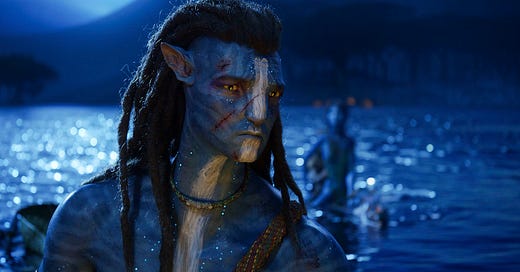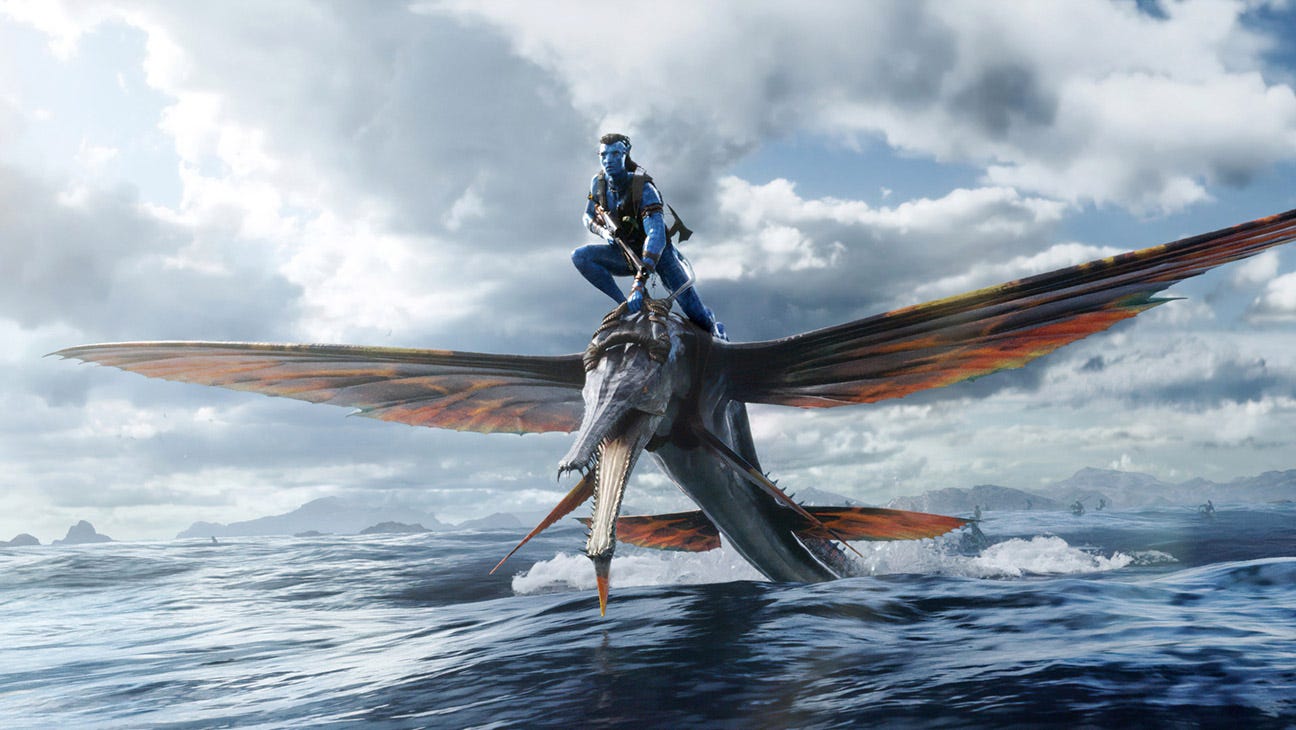Avatar: The Way of Water stuns and mystifies
The long-awaited follow-up doubles down on the original's strengths (and weaknesses)
George R. R. Martin’s The Winds of Winter; Valve’s Half-Life 2: Episode 3 (or even Half-Life 3); James Cameron’s Avatar 2 - these projects and more have all become shorthand for development hell, procrastinating creators, and fruitless hope for a continuation that may never come. But a follow-up to Cameron’s mammothly successful space epic (becoming the highest-grossing film of all time, then losing that distinction to Avengers: Endgame, only to regain it through re-releases - screw it, they’re both owned by Disney, so who cares) seemed inevitable, yet Cameron’s notorious perfectionism ballooned the scope of the nascent franchise. One sequel became two, which became four, and it appeared as if we would never get to return to the visually lush and politically simple world of Pandora. But not all famously stalled projects stay that way forever; a select few break through the inertia and take the radical step of *existing*. At the AMC Lincoln Square, as Nicole Kidman concluded her now iconic treatise on the power of the movies, I experienced this evanescent out-of-body experience, as if I was peering into another dimension to witness something that does not and could not exist in my own world. That something is Avatar: The Way of Water, representing more than a decade of anticipation from general audiences who wanted to see it happen and cynical detractors who wanted to see it fail. If you were expecting any major reinvention in one direction or the other, however, don’t hold your breath; Cameron’s first film in 13 years doubles down on what made the original work - and also what held it back.
The original Avatar suffered countless critiques - dated dialogue, grade-level thematics, problematic exploitation - but they all seemed to revolve around a lackluster script (written exclusively by Cameron) at the core of the experience. What made the original film so captivating to audiences around the globe was its aesthetic qualities, its worldbuilding, its pioneering special effects, NOT the story or the characters. But no matter how cliché the narrative or characterizations were, they were there. An admittedly simple story that followed all of the traditional inflection points laid a solid framework for Cameron to test out his toys. But his sequel, despite crediting two additional screenwriters, has somehow regressed on a narrative level. I had hoped that, since he had already established the world and its heroes in the last film, Cameron would pay more care to his script, but the plot here is excruciatingly thin. As a matter of fact, there is barely any plot to speak of. To be sure, plenty happens in this 192-minute epic, but viewing the narrative on a macro level reveals a surprisingly hollow throughline. The film is wildly uneven, lacking a clear objective to push the story forward. Most of the film’s second act is slice-of-life as Jake and his threatened family flee to the water clan and learn the titular way of water; these portions are conceptually interesting and visually stunning, but by the time that the film enters its third act, I hadn’t realized how close to the end we were. This is certainly a testament to the film’s exceptional pacing, but it also reflects a structure that lacks rising tension.
In many ways, the film feels surprisingly derivative of the original - Jake is once again a fish out of water (pun absolutely intended), and humankind once again threatens the natural balance, leading to another climactic showdown. But the most disappointing aping of the original is in its antagonist Quaritch. Stephen Lang returns as a Na’vi clone created using memories conveniently uploaded just before the original film’s climax. Cameron handwaves this retcon away, but this decision and its execution just feel lame and uninspired. Lang’s performance, informed by mediocre writing, was always one of the weak spots of the original, but that being said, more is done here to grant him some much-needed dimensionality, introducing an annoying bastard son (another retcon) named Spider that forces Lang to play a wider range of emotions. Family seems to be Cameron’s main tool in his attempt to elevate the material; Jake and Neytiri (the latter being one of the best parts of the original yet is shamelessly sidelined here) now have a family of their own - three biological children (two sons and one daughter), an adopted child (the mysteriously conceived teenage daughter of Sigourney Weaver’s Grace, introducing yet another ret-con), and the hanger-on Spider. Cameron uses this family dynamic to ground his narrative, arguably making it the central thematic question of the story. Of all of these newcomers, Weaver’s Kiri (yes, 73-year old Weaver plays both herself and her teenage daughter) is a stand-out, and particular attention is paid to developing her identity, though oftentimes at the expense of the rest of the family.
The film almost feels like a set-up for future stories in this world, reintroducing audiences to Pandora and Cameron’s thematic aims. But what exactly are those thematic aims? The original film was an obvious critique of Western colonialism, featuring a strong environmentalist message at its heart. This sequel retains that framing, but its environmentalism proves more effective here. The climate crisis has only worsened since 2009 (people back then were more concerned about the economy than the environment), making Cameron’s heavy-handed approach seem a bit lighter, more digestible and appealing to a general audience. But his political commentary continues to fall flat. “Colonialism is bad” - okay, and? What exactly does Cameron have to add to the conversation? His perspective is superficial at best and counterproductive at worst; we don’t need to sympathize with the imperialists, but what does it say that humanity would continue doing this in the future? If there were more uncharted lands to conquer in our own time, would the great powers repeat the atrocities of European colonization? Have we really learned anything? Disappointingly, none of these questions are explored by Cameron. Furthermore, one wonders if Cameron should even be the one to tell this story; the Na’vi may be fictional, but little is done to culturally distinguish them from real indigenous communities. Couple this with well-intentioned but horribly insensitive comments by Cameron, and it’s no wonder that many have called for a boycott of the film entirely. While I’m not completely convinced that we should waste our outrage on this dumb film with giant blue alien cats, these concerns hold weight and should hopefully inspire continued change in a changing industry.
As this astute Letterboxd review phrases it, “Cameron is moving into a form of storytelling entirely of allegory and emotion. Narrative is secondary to sensation.” And sensation is where Cameron shines. He’s always been able to add an intensity and viscerality to his work, but his glorified tech demo is a true wonder to behold. In the realm of computer-generated imagery, the visual effects crafted here are probably the greatest of all time. The water clan, the environments, the characters - everything from the sprawling ocean to a distinct drop of water is beautifully rendered. This has become such a cliché, but you really feel like you’re there - this film has completely obliterated the uncanny valley (for those willing to put in the effort). Even the original film still holds up compared to the deluge of shoddy work by overworked and underpaid VFX artists today, but Cameron’s perfectionism is on full display and a much-needed salve for audiences. But this visual majesty cannot be solely attributed to a series of code; the cinematography itself is often breathtaking, with strong compositions that draw attention to Cameron’s directorial skills. But the greatest technological innovation, of both this film and its predecessor, is the motion capture technology. Much noise has been made about the underwater sequences and its production, but it's the subtlety and nuance that technology allows that should be celebrated the most. The original film revolutionized the technology, but I hope to see more recognition from an industry that still doesn’t take the practice seriously.
It’s only fitting that James Cameron would force me to write my longest review yet, but there’s just so much to say about Avatar: The Way of Water, despite its often feeling a bit empty and aimless. But for all of his faults, Cameron has proven his full commitment to this franchise, which will likely be his last. The script has glaring issues, but they seem more misguided than anything else - they’re certainly not lazy, nor is Cameron himself. To iterate on Mel Brook’s classic line from Spaceballs, this film could have easily just been Avatar 2: The Search for More Money, but Cameron avoids this pitfall with stunning technical innovation paired with a narrative light on plot but heavy on emotion. Pandora is back and bigger than ever - and it demands to be seen on the biggest screen that you can find, in 3D, with HFR. But I don’t think that it will have the legs to unseat its predecessor, or, for that matter, cross the $2 billion mark. As inflation rises and wages stagnate, audiences will have to decide how enchanting Pandora really is. Cameron makes a compelling case, but the final verdict remains to be seen.









